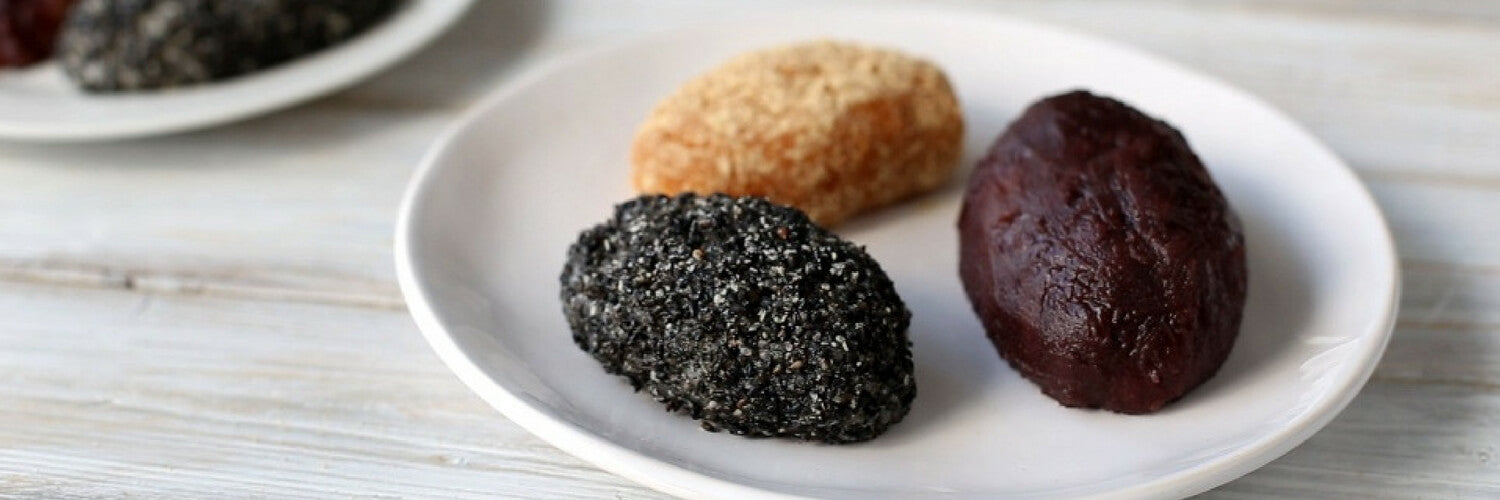
Introducing three most popular ways of eating mochi. Try making all three of them and find out which one is your favorite!
Ohagi and Botamochi are traditional Japanese sweet dumplings for Higan, a public holiday in Japan. Higan happens in spring around the vernal equinox and in autumn around the autumn equinox. This is why there are two different names for these traditional Japanese “wagashi,” or delicious Japanese confections.
Ohagi, which is eaten in the fall, and Botamochi, which is eaten in the spring, both consist of sweet rice, known as “mochi gome,” and sweet red bean paste. While both made in the same flower shape, Ohagi is named after the bush clover (hagi), which blooms in fall, while Botamochi is named after the spring blooming peony (botan).
Ohagi and Botamochi are both sweet and delicious and easy to make in your own kitchen. There are really three different ways to make Ohagi and Botamochi—with red bean paste, with sesame seeds or with kinako (soybean powder)—but all of these follow the same basic recipe.
All About Higan
The equinoxes have a special meaning in Buddhism, as they all signify a time of balance between seasonal changes. In Japan, there are seven-day festivals, including Haru no Higan in the spring and Aki no Higan in the fall.
Many people return to their hometowns for Higan to enjoy their families and make Ohagi or Botamochi. Just one of the many traditional Japanese festivals throughout the year, Higan is a celebration of the abundance of nature.
More About Red Bean Paste
Ohagi and Botamochi are very popular because of their rich, sweet taste. But they also come in two varieties that you should be aware of before you cook them up at home.
One is koshian (smooth red bean paste), and the other is tsubuan (chunky red bean paste). Chunky red bean paste tastes sweeter even though it contains the same amount of sugar. This is because chunky red beans stay in the mouth longer than do smooth ones. So, if you’re on diet but want to eat something sweet, choose tsubuan!
Also check out our complete guide to making red bean paste from scratch at home.
When to Serve Ohagi and Botamochi
While it’s true that these sweet rice dumplings are usually only eaten during Higan in Japan, they also make great snacks that go with tea or coffee. Having them on hand, or whipping some up when guests stop by, is a great way to impress company with your knowledge of traditional Japanese cooking techniques.
Our recipe and video allow you to make your own Ohagi and Botamochi at home in no time at all. And, while you might need some traditional Japanese cooking ingredients from a specialty grocery or online store, you can also play around with your own creative takes on these yummy sweet rice dumplings!
Ohagi/ Botamochi 3 Kinds

Ingredients
- 2 cup Mochi Gome
- 1 cup Red Bean Paste (Koshi An)
- 5 Tbsp Ground Black Sesame Seeds
- 5 Tbsp Kinako (Soybean Powder)
- 7 Tbsp Sugar
Instructions
- Wash mochi gome rice with cold water. Drain the water and let it sit for about 30 minutes. Cook mochigome as instructed on the package.
- Allow the cooked rice to settle, then move rice into a bowl and mash it with a spoon until sticky.
- Separate the rice into 9 pieces and form round shape.
- Split the red bean paste into thirds. Spread one part on a plastic wrap and place a mochi ball on top. Cover the mochi with red bean paste using saran wrap. Repeat and make two more.
- In a small bowl, mix three tablespoons of sugar and ground black sesame seeds. Sprinkle sesame mixture on 3 mochi balls.
- In another small bowl, mix the rest of sugar and kinako. Sprinkle kinako mixture on 3 mochi balls.
